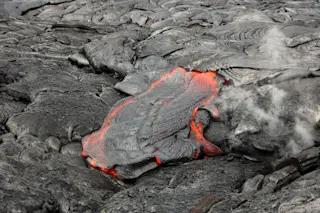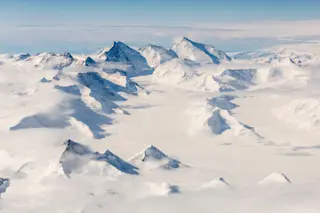Breakout of lava on the East Rift Zone of Kilauea, seen March 12, 2013. Image: Erik Klemetti Yesterday I posted some images of the lava flow we visited on our Department field trip to Hawaii ... and as promised, today I have some video from the lava flow field on Kilauea. Now, I'm no cinematographer -- all these videos were shot with my iPhone, which I was trying to hold steady in a sea of excited students and faculty. However, these videos do show a lot of the lava flow dynamics I talked about in yesterday's post. Let's take a look.
Coalescing Pahoehoe Toes
Yesterday I said that many lava flows grow by budding new pahoehoe toes that eventually coalesce into lobes. Here is an example of just that happening -- three toes (one rather large on the left) move towards each other. You can see the flexible skin that has formed on the flow bends easily as the toes coalesce. The middle toe gets stretched and flatted by the two toes on either side as a new lobe forms. This video also shows how the newly formed lava skin stretches at the point of the breakout but cools again as it moves away. Note: I removed the audio from this clip due to chatter in the background.
Lava Ropes
Here we have two small breakouts from a ropey pahoehoe flow. The first spills out quickly, adding a large lobe of new ropey pahoehoe (the lobe is ~1 meter across). The second, smaller breakout is much cooler lava, oozing out slowly from a crack between some of the ropey surface of the flow. This lava drips out and quickly becomes more viscous as it cools, forming thicker bands of rope than the other, larger breakout. You can see these breakouts are part of a ropey flow that comes down off the ledge in the back of the video. However, notice how different the texture is between this very ropey flow and the smooth, solidified flow to the left -- these seem to be all inflated pahoehoe toes and lobes rather than the piles of ropey pahoehoe skins that the active part of the flow is forming. Likely this is related to flow rate and the style of the breakout -- sheets rather than toes.
Lava Falls
I love this video of the twin lava falls (~2-3 meters across) that we caught as part of the breakout. Not only can you see how runny (relatively speaking) the lava is at the point of the breakout, but also how quickly a darker skin begins to form. That skin can begin to pile up as ropey pahoehoe quite quickly after the lava has left the breakout. Sometimes that skin can be "refloated" as the flow inflates beneath it as you can see in the bottom part of the active flow, where the surface is smoother and new budding toes are forming. Right at the breakout, the lava is glowing yellow/orange, but quickly that surface cools to more of a red/orange. You could use an optical pyrometer to estimate the changing temperatures of the surface of the lava based on the color of the lava itself. All video shot by Erik Klemetti -- March 12, 2013.














